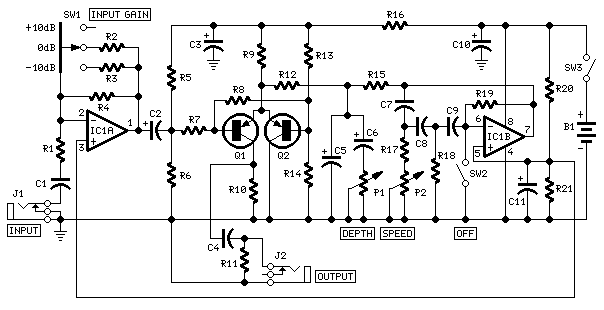Circuit diagram:

Parts:
P1______________22K Log Potentiometer P2______________22K Linear Potentiometer R1,R6__________150K 1/4W Resistors R2_____________220K 1/4W Resistor R3______________56K 1/4W Resistor R4_____________470K 1/4W Resistor R5______________68K 1/4W Resistor R7______________39K 1/4W Resistor R8,R13___________3K9 1/4W Resistors R9______________15K 1/4W Resistor R10,R11,R15_____10K 1/4W Resistors R12______________6K8 1/4W Resistor R14,R17__________5K6 1/4W Resistors R16____________330R 1/4W Resistor R18_____________47K 1/4W Resistor R19______________1M 1/4W Resistor R20,R21_________22K 1/4W Resistors C1,C7,C8,C9____330nF 63V Polyester Capacitors C2______________10µF 25V Electrolytic Capacitor C3,C10,C11_____100µF 25V Electrolytic Capacitors C4______________47nF 63V Polyester Capacitor C5_______________2µ2 25V Electrolytic Capacitor C6_____________220µF 25V Electrolytic Capacitor Q1,Q2_________BC557B 45V 100mA PNP Transistors (or 2N3906) IC1____________TL062 Low current BIFET Dual Op-Amp J1,J2__________6.3mm. Mono Jack sockets SW1____________1 pole 3 ways rotary or slider switch SW2______________SPST Toggle, slider or Pedal Switch SW3______________SPST Toggle or slider Switch B1_________________9V PP3 Battery Clip for PP3 Battery
Comments:
In the old days of tube guitar amps a tremolo circuit, i.e. an amplitude modulator of the input audio signal, was invariably present, even in the cheapest amplifiers. In practice, the signal level was increased and decreased at a rate typically ranging from about 5 to 10 times per second.
This effect is no longer available in most modern guitar amps, but since some players like to use it yet, a stand alone, 9V battery powered tremolo unit primarily intended for electric guitars was designed on request.
Circuit description:
IC1A is wired as a linear input amplifier. The input sensitivity of the circuit can be varied from -10dB to +10dB in three fixed steps by means of SW1, in order to cope with almost any pick-up type and model. The audio signal is then routed to the modulator stage formed by a transistor long-tailed pair (Q1 and Q2) whose tail current is made variable by the output voltage of a sine wave generator. The amplitude modulator circuitry is rather complex if compared to usual tremolo circuits, but it allows superior distortion and overload margin performance. IC1B is wired as a sine wave phase-shift oscillator: its output frequency can be varied in the 5Hz - 10Hz range by means of P2 (Tremolo Speed Control).
P1 is the Tremolo Depth Control: a more or less heavy modulation of the tail current of Q1 and Q2 is obtained by a partial shunting, through the network formed by R12, R15, C5, C6 and P1, of the sine wave generated by IC1B. If a log potentiometer is used for P1, as recommended, a very fine Depth Control will be obtained, ranging from a fixed tone to a gently wavering sound and finally to a more in-deep modulated tremolo.
C4 and R11 form a 160Hz high-pass filter, necessary to reduce the presence of unwanted 5-10Hz frequencies at the output of the circuit.
Notes:
- P1 pins connection: with the shaft of the pot pointing toward you and the three pins pointing down, connect C6 to the leftmost pin and the remaining two pins to negative ground.
- P2 pins connection: with the shaft of the pot pointing toward you and the three pins pointing down, connect R17 to the rightmost pin and the remaining two pins to negative ground.
Technical data:
- Input Gain:
- Three selectable positions: +10dB, 0dB and -10dB
- Maximum Input Voltage:
- 250mV RMS for undistorted output (SW1 set to 0dB)
- 750mV RMS for undistorted output (SW1 set to -10dB)
- 85mV RMS for undistorted output (SW1 set to +10dB)
- Speed:
- Adjustable from 5 to 10Hz
- Total current drawing:
- 1.7mA